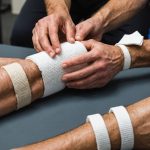Mastering Bandage Selection: A Comprehensive Guide to Dressing Various Injuries Effectively
When it comes to treating injuries, the right bandage can make all the difference. Whether you are a medical professional, a member of the military, or simply someone who wants to be prepared for medical emergencies, understanding how to select and use the appropriate bandages is crucial. In this guide, we will delve into the world of bandage selection, exploring the different types, their uses, and the essential considerations for effective wound care.
Understanding the Types of Bandages
Bandages come in a variety of forms, each designed to address specific types of injuries. Here’s a detailed look at some of the most common types:
Also read : Mastering Your Sleep: Tips for Adapting to Shift Work While Prioritizing Your Health
Gauze Bandages
Gauze bandages are perhaps the most versatile and widely used. They are available in various sizes and can be used to dress wounds, apply pressure, or secure other dressings in place.
- Gauze Pads: These are pre-cut pieces of gauze that can be placed directly on a wound to absorb blood and other fluids.
- Gauze Rolls: These are long, rolled strips of gauze that can be wrapped around injuries to provide support and secure dressings.
- Gauze Sponges: These are small, square pieces of gauze often used for cleaning and dressing small wounds.
Elastic Bandages
Elastic bandages, also known as ACE bandages, are used to provide support and compression to injured areas. They are particularly useful for sprains, strains, and other soft tissue injuries.
Also read : Crafting an All-Inclusive Eczema Management Blueprint: Your Essential Guide
- Uses: Elastic bandages can help reduce swelling, provide stability, and offer support to injured limbs.
- Application: They should be wrapped snugly but not too tightly, as excessive pressure can cut off circulation.
Adhesive Bandages
Adhesive bandages, commonly known as Band-Aids, are small, pre-made bandages with an adhesive strip. They are ideal for minor cuts and scrapes.
- Uses: Adhesive bandages protect the wound from dirt and bacteria while keeping it moist to promote healing.
- Application: Simply peel off the backing and apply the bandage to the injured area.
Hemostatic Bandages
Hemostatic bandages are designed to stop bleeding quickly and are often used in military and emergency medical situations.
- Uses: These bandages contain hemostatic agents that help to clot blood rapidly, making them essential for severe bleeding injuries.
- Application: Apply the hemostatic bandage directly to the wound, pressing firmly to ensure good contact.
Essential Considerations for Effective Wound Care
When it comes to dressing wounds, several factors must be considered to ensure effective care and promote healing.
Cleanliness
Maintaining cleanliness is pivotal in wound care. Here are some steps to follow:
- Clean the Wound: Use sterile saline solution or clean water to rinse the wound. Avoid using harsh soap or other cleansers that can irritate the skin.
- Dry the Area: Gently pat the area around the wound dry with a clean towel.
- Apply Antiseptic: If necessary, apply a thin layer of antiseptic ointment to help prevent infection.
Choosing the Right Dressing
The type of dressing used can significantly impact the healing process.
- Assess the Wound: Determine the size, depth, and type of wound to choose the appropriate dressing.
- Consider the Environment: For example, in a military or outdoor setting, a more durable and water-resistant dressing may be necessary.
Securing the Dressing
Ensuring the dressing stays in place is crucial for effective wound care.
- Use Medical Tape: Secure the dressing with medical tape, making sure not to tape too tightly.
- Monitor and Adjust: Regularly check the dressing and adjust as necessary to ensure it remains in place.
The Role of Bandages in Military Operations
In military operations, bandages play a crucial role in providing immediate medical care in the field.
Military-Grade Bandages
Military-grade bandages are designed to be more durable and effective in high-stress environments.
- Hemostatic Agents: Military bandages often include hemostatic agents to quickly stop severe bleeding.
- Water-Resistant: These bandages are typically water-resistant to ensure they remain effective in various conditions.
Training and Kits
Military personnel undergo extensive training in wound care and are equipped with specialized medical kits.
- Individual First Aid Kits (IFAKs): These kits contain essential medical supplies, including various types of bandages, to treat common injuries.
- Buddy Aid: Training includes how to provide aid to fellow soldiers, emphasizing the use of bandages to stabilize injuries until professional medical attention can be received.
The Importance of Medical Supplies and Technology
Advancements in medical supplies and technology have significantly improved wound care.
Modern Bandage Materials
New materials and technologies have led to the development of more effective bandages.
- Antimicrobial Properties: Some bandages now include antimicrobial properties to reduce the risk of infection.
- Breathable Materials: Breathable bandages help maintain a healthy environment around the wound, promoting faster healing.
Wound Healing Products
Various products are designed to support the wound healing process.
- Gel Dressings: These dressings provide a moist environment that promotes healing and reduces the risk of scarring.
- Foam Dressings: These are used for wounds that require extra cushioning and protection.
Practical Advice and Examples
Here are some practical tips and examples to help you master bandage selection and use:
Example: Treating a Sprain
If someone sprains an ankle, an elastic bandage can be used to provide support and reduce swelling.
- Application: Wrap the elastic bandage around the ankle, ensuring it is snug but not too tight.
- Monitoring: Check the bandage regularly to ensure it is not cutting off circulation.
Example: Using Hemostatic Bandages
In a situation where severe bleeding occurs, a hemostatic bandage can be a lifesaver.
- Application: Apply the hemostatic bandage directly to the wound, pressing firmly to ensure good contact.
- Monitoring: Monitor the wound for signs of clotting and adjust the bandage as necessary.
Training and Education
Training and education are essential for ensuring that individuals can effectively use bandages in various situations.
Medical Training
Professional medical training emphasizes the proper use of bandages and other medical supplies.
- Courses: Many medical courses include hands-on training in wound care and bandage application.
- Simulations: Simulation exercises help medical personnel practice their skills in realistic scenarios.
Community First Aid Courses
Community first aid courses are available for the general public to learn basic first aid skills, including bandage use.
- Courses: These courses cover the basics of wound care, including how to clean, dress, and secure wounds.
- Certification: Many courses offer certification upon completion, which can be beneficial in emergency situations.
Mastering bandage selection and use is a crucial skill that can make a significant difference in the care and treatment of injuries. Whether you are in a medical, military, or everyday setting, understanding the different types of bandages, their applications, and the essential considerations for effective wound care is pivotal.
As Tom Kirkman from the “Mastering Rod Building” podcast might say about the importance of attention to detail, “Starting simply and focusing on functionality over aesthetics is key.” Similarly, in wound care, focusing on the right bandage and proper application can ensure effective healing and support.
Here is a summary of the key points in a detailed bullet point list:
-
Gauze Bandages: Used for dressing wounds, applying pressure, and securing other dressings.
-
Gauze pads for direct wound application
-
Gauze rolls for wrapping around injuries
-
Gauze sponges for cleaning and dressing small wounds
-
Elastic Bandages: Provide support and compression for sprains and strains.
-
Used to reduce swelling and provide stability
-
Applied snugly but not too tightly
-
Adhesive Bandages: Protect minor cuts and scrapes.
-
Keep the wound moist to promote healing
-
Easy to apply and remove
-
Hemostatic Bandages: Contain agents to stop severe bleeding quickly.
-
Used in emergency and military situations
-
Apply directly to the wound and press firmly
-
Cleanliness: Clean the wound with sterile solution or clean water.
-
Dry the area around the wound
-
Apply antiseptic if necessary
-
Securing the Dressing: Use medical tape to secure the dressing.
-
Monitor and adjust the dressing as necessary
-
Military Operations: Military-grade bandages are durable and include hemostatic agents.
-
Training includes buddy aid and the use of IFAKs
-
Medical Supplies and Technology: Modern bandages include antimicrobial and breathable materials.
-
Products like gel and foam dressings support the healing process
-
Training and Education: Professional medical training and community first aid courses are essential.
-
Hands-on training and simulations prepare individuals for real scenarios
By understanding and applying these principles, you can ensure that you are providing the best possible care for injuries, whether in a medical setting, military operations, or everyday life.
Table: Comparison of Common Bandage Types
| Bandage Type | Use | Application | Special Features |
|---|---|---|---|
| Gauze Bandages | Dressing wounds, applying pressure | Direct application or wrapping | Absorbent, breathable |
| Elastic Bandages | Providing support and compression | Wrapping around injured area | Reduces swelling, provides stability |
| Adhesive Bandages | Protecting minor cuts and scrapes | Peel and stick | Keeps wound moist, easy to apply |
| Hemostatic Bandages | Stopping severe bleeding | Direct application, press firmly | Contains hemostatic agents, water-resistant |
Quotes and Insights
- “The right bandage can make all the difference in wound care. It’s about understanding the injury and choosing the best tool for the job,” said a medical professional during a training session.
- “In military operations, having the right medical supplies, including bandages, can be the difference between life and death. It’s crucial to know how to use them effectively,” emphasized a veteran.
- “Bandages are not just about covering a wound; they play a pivotal role in the healing process. Proper use and selection are essential,” noted a healthcare expert.
By mastering the art of bandage selection and use, you can provide effective care and support for various injuries, ensuring the best possible outcomes in any situation.











